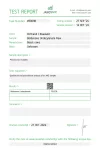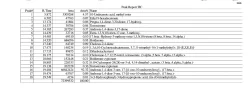Btw let's make a discord for anyone interested? Would be easier to coordinate for future testings etc
To keep results all organized and ideas as well
To keep results all organized and ideas as well
Follow along with the video below to see how to install our site as a web app on your home screen.
Note: This feature may not be available in some browsers.
As soon as you find something that fails these tests, you’ll get a ton of support.
Second this; creating a Discord for anyone interested in these enhanced testing discussions along with donating would help immensely. @readalotBtw let's make a discord for anyone interested? Would be easier to coordinate for future testings etc
To keep results all organized and ideas as well
Endotoxin tests can also be performed on AAS oils. In fact, I just send off a vial to be tested for endotoxins, based on the advice of Sir readalot.I havn't gone through all the posts yet, so this may have already been addressed...
Someone correct me if I'm wrong. I believe vendors do HPLC testing per batch, whereas Readalot's "additional testing" is for vendor raws. These "additional tests" will capture endotoxins, etc. on vendor raws, thereby tests/results will be much less frequent.
You guys don’t look at the endpoint though.Just doing the test helps keep everyone honest. If there is an incentive to cut a corner here and there or not be thorough..
How is @readalot ’s expanded testing going to be verifiable? Periodic spot testing costing $1,000s?
Thank you very much for setting up the thread. Yes I can just as soon as I have the proper time. Got a lot going on this week but we should have a proper description of these tests before you get the results. Fantastic work Dirthand. I appreciate you.@readalot do you care to explain and share the details of the testing being performed??
1. Hplc Purity - 120 usd
2. GCMS - 170 usd
3. Expanded metals list for standard list price (personally approved by Jano via xxxxxxxxx) - 60 usd
4. endotoxins - 120 usd
5. Residual solvent poor man's test (KF+loss on drying) - 60 usd
6. Shipping 45 usd
7. total - 575 usd
Maybe individuals just repeat a single test, and with some coordination from multiple people you can replicate all of them. Maybe vendors expand their testing credit to cover more tests, which they can afford due to the small premium per vial.How is @readalot ’s expanded testing going to be verifiable? Periodic spot testing costing $1,000s?
Yea I gotta pipe down. I’m disturbing the echo chamber and this isn’t a discussion. I realize the questions I’m asking are less important because I’m not blindly running down this same path. I’d like to consider the destination first so I don’t fuck up the route we use to get there.We'll cross that bridge when we come to it. In the meantime, settle down. You're starting to come across like one of those cliche types that tries to stand in the way of progress.
Appreciate any and all feedback/criticism to improve this thing.. I don’t want this to be remembered as Readalot’s Folly.
Hey Bro,Yea I gotta pipe down. I’m disturbing the echo chamber and this isn’t a discussion. I realize the questions I’m asking are less important because I’m not blindly running down this same path. I’d like to consider the destination first so I don’t fuck up the route we use to get there.
I’m not standing in the way of progress. If the community is going to support this, these are the things that should be considered.
I’d like to see additional testing where it makes sense. I don’t want this to be remembered as Readalot’s Folly.
Yea I gotta pipe down. I’m disturbing the echo chamber and this isn’t a discussion. I realize the questions I’m asking are less important because I’m not blindly running down this same path. I’d like to consider the destination first so I don’t fuck up the route we use to get there.
I’m not standing in the way of progress. If the community is going to support this, these are the things that should be considered.
So @janoshik, a question is how the customer will use the result from your GCMS screening on AAS samples since this is non targeted analysis, and the tentative IDs are sent to the customer without any additional interpretation or analysis of the m/z ratios of the individuals GC peaks. Is it up to the customer to examine the m/z data (not likely) or is there any extra charge for interpretation of the raw data? I don't see how the layperson customer is not going to potentially get false positives on the test in its current offering.Jano approved me sharing this nice lecture on GCMS interpretation. I had a bunch of questions on the result so he made me an audio reply. Really reinforces the message around targeted vs non targeted analysis and caution on the standard output from the GCMS output with library automatic hits.
Code:https://vocaroo.com/1bWVYclimeam
Gcms screening I do usually provide some sort of a comment usually not as extensive but I do.So @janoshik, a question is how the customer will use the result from your GCMS screening on AAS samples since this is non targeted analysis, and the tentative IDs are sent to the customer without any additional interpretation or analysis of the m/z ratios of the individuals GC peaks. Is it up to the customer to examine the m/z data (not likely) or is there any extra charge for interpretation of the raw data? I don't see how the layperson customer is not going to potentially get false positives on the test in its current offering.
Thanks for your thoughts.
So for example with the tibolone variant tentative hit, you would typically provide the customer a comment that this tentative hit is in error?Gcms screening I do usually provide some sort of a comment usually not as extensive but I do.
CorrectSo for example with the tibolone tentative hit, you would typically provide the customer a comment that this tentative hit is in error?
That would be nice for folks who aren't going to run questions up the flagpole as much as I do.
For a representative AAS raw, how closely will the HPLC purity align with estimated purity from GCMS area count? A few percent difference? Response factors for all these usual suspects should be pretty close?
Yes great point we talked about. HPLC may be lumping the AAS ester and it's -ene variant. Thanks for daylighting that!Correct
And while the gcms area counts need to be taken with a grain of salt, HPLC might not be able to separate a single bond difference without very specialized methods.


Beware!View attachment 301842
90.52% HPLC
View attachment 301849
92.32% GCMS area count approximation
Nice work!
I thought it was both. Got busted, got his shit taken. Then did an "exit sale" to get some extra cash afterWait, Astro was busted? I thought he exit scammed and later a vendor that he resold for (bio something) came here looking for him and his money.
I remember Astro well as he was my first vendor to use here. I loved that he was Karl’s ex brewer and kinda screwed him over if my memory serves me well
@biggerben69 @brutaltarik
Thank you for the additional comments on relative volatilities and their impact on estimated/apparent purity via GCMS. As MS is the detector I appreciate your points on ionization and cutoff mass as well. Truly the GCMS service you offer, in its current format, is a great screening tool if results are interpreted correctly.Beware!
You cannot count on GCMS to have all constituents of the sample to have same behaviour when turned volatile - eg. if you volatilize fatty acid methyl ester (1st peak) a lot of it is going to get 'through' to the detector, because that sort of thing wants to turn volatile very much.
However, high boiling point stuff, such as boldenone u. itself is not so keen on turning into gas, so a lower % of it gets through.
Then you have the issue of how much does something want to ionize.
Then you have the issue of how many ions are under cutoff mass.
There's simply too many factors at play with GCMS and area counts are not possible to use to determine purity unless *all* the major contaminants behave very similarly.
The numbers coming back similar is much more likely to be a random chance than the methods being comparable.

